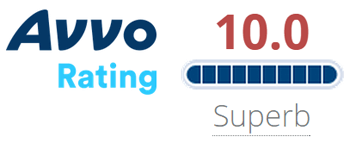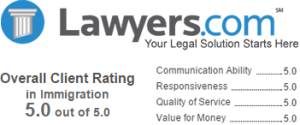STATEMENT OF JURISDICTION
This is an appeal from a final decision of the United States District Court for the Central District of California. On March 26, 2004, the District Court filed an “Order Denying Plaintiffs’ Motion for Summary Judgment and Dismissing the Action.” This case concerns section 5 of the Nursing Relief for Disadvantaged Areas Act of 1999 (“NRDAA”), Pub. L. 106-95, 113 Stat. 1312, codified at 8 U.S.C. § 1153(b)(2)(B)(ii)(I) and the contradictory interim rule of September 6, 2000 (65 Fed. Reg. 53889-53896) issued by the U.S. Citizenship and Immigration Service (“CIS”) to administer the NRDAA. This Court has jurisdiction to review whether the CIS’ rules conflict with the statute pursuant to 28 U.S.C. § 1331 (federal question jurisdiction) and 5 U.S.C. § 702 (the Administrative Procedures Act).
STATEMENT OF ISSUE
Whether the District Court should have voided the CIS’ interim rules as inconsistent with the plain language of the statute?
Client Reviews

Legal Guru in All Things Immigration
“Mr. Shusterman and his law firm have represented my family and me very successfully. He is not only a legal guru in all things immigration but even more so he is an exceptional human being because he empathizes with his clients and cares that justice is done.”
- Maria Davari Knapp, Chicago, Illinois
Read More Reviews
Zoom Consultations Available!
STATEMENT OF THE CASE
On December 4, 2002, the Petitioners filed a complaint for declaratory and injunctive relief before the U.S. District Court for the Central District of California. The compliant sought to make consistent the CIS interim rule of September 6, 2000 (65 Fed. Reg. 53889-53896) with the statute (8 U.S.C. §1153(b)(2)(B)(ii)(I)). The Petitioners requested that the District Court strike down those sections of the rule which are inconsistent with the statute. On December 9, 2002, the Petitioners filed an amended complaint. On April 7, 2003, the Respondent filed an answer to Petitioners’ amended complaint. On March 26, 2004, the District Court denied the Petitioners’ Motion for Summary Judgment and dismissed the action. [See Excerpts of Record, p. 4, hereinafter “Record”]. The District Court found the regulations to be consistent with the statute. On April 14, 2004, the Petitioners filed a timely appeal to this Court. [Record, p. 1].
STATUTORY FRAMEWORK
Section 5 of the NRDAA amended section 203(b)(2)(B)(ii) of the Immigration and Nationality Act (“INA”), 8 U.S.C. § 1153(b)(2)(B)(ii), to provide that –
The Attorney General shall grant a national interest waiver…on behalf of any alien physician with respect to whom a petition for preference classification has been filed…if—
(aa) the alien physician agrees to work full time as a physician in an area or areas designated by the Secretary of Health and Human Services as having a shortage of health care professionals or at a health care facility under the jurisdiction of the Secretary of Veterans Affairs; and
(bb) a Federal agency or a department of public health in any State has previously determined that the alien physician’s work in such an area or at such facility was in the public interest. [emphasis added] 8 U.S.C. §1153(b)(2)(B)(ii)(I).
Before a physician with an approved NIW petition is eligible to adjust status to permanent resident, he or she must work full time for an aggregate of five years in a medically underserved area. 8 U.S.C. §1153(b)(2)(B)(ii)(II). The law makes an exception for any physician who had an NIW petition filed on his or her behalf prior to November 1, 1998. Such physicians are only required to have worked full time for an aggregate of three years in a medically underserved area. 8 U.S.C. §1153(b)(2)(B)(ii)(IV).
The structure of the statute is very simple: Any alien physician who practices medicine for an aggregate of five or three years in an area designated as having a shortage of healthcare professionals or at a VA facility may be granted permanent residence after the required time is served.
REGULATORY FRAMEWORK
On September 6, 2000, the CIS published an interim rule to implement section 5 of the NRDAA at 65 Fed. Reg. 53889-53896. The rule provides that an alien physician shall be granted an NIW if:
(1) The physician agrees to work full-time (40 hours per week) in a clinical practice for an aggregate of 5 years…; and
(2) The service is
(i) In a geographical area or areas designated by the Secretary of Health and Human Services (HHS) as a Medically Underserved Area, a Primary Medical Health Professional Shortage Area, or a Mental Health Professional Shortage Area, and in a medical specialty that is within the scope of the Secretary’s designation for the geographical area or areas; or
(ii) At a health care facility under the jurisdiction of the Secretary of Veterans Affairs (VA); and
(3) A Federal agency or the department of public health of a State… has previously determined that the physician’s work in that area or facility is in the public interest. [emphasis added] 8 C.F.R. §204.12(a).
Additionally the rule provides that-
(1) If the physician already has authorization to accept employment (other than as a J-1 exchange alien), the beneficiary physician must complete the aggregate 5 years of qualifying full-time clinical practice during the 6-year period beginning on the date of approval of the Form I-140 [NIW petition].
(2) If the physician must obtain authorization to accept employment before the physician may lawfully begin working, the physician must complete the aggregate 5 years of qualifying full-time clinical practice during the 6-year period beginning on the date of (sic) the Service issues the necessary employment authorization document. <!–[if !supportFootnotes]–> [1] <!–[endif]–>
[emphasis added] 8 C.F.R. § 204.12(b)(1), (2).
PETITIONERS’ INDIVIDUAL FACTS
1. Dr. Anwar Tandar
For a period of almost six years, from August 26, 1997 to June 20, 2003, Dr. Anwar Tandar was employed as a physician at the Fallon Clinic’s Saint Vincent Hospital located in Worcester, Massachusetts, a medically underserved area, in H-1B specialty occupation status. An NIW petition was submitted on his behalf prior to November 1, 1998 and was denied by the CIS on June 21, 1999. [Record, pp. 42-43].
On January 16, 2001, a second NIW petition was submitted on Dr. Tandar’s behalf and was approved on September 8, 2001. [Record, p. 44]. Thereafter, on November 13, 2001 Dr. Tandar submitted an application for adjustment of status to permanent resident, which is still pending. On May 21, 2002, the CIS notified Dr. Tandar that because his NIW petition was not approved until September 8, 2001, he is subject to the five-year medical service requirement which will not end until September 8, 2006. [Record, p. 45].
2. Dr. Muhammad Sattar
Since July 23, 1996, Dr. Muhammad Sattar has been employed as a physician in a medically underserved area in H-1B status. [Record, pp. 48-55]. Dr. Sattar received a waiver of the J-1 home residency requirement on March 6, 1996, (Record, p. 56]. On July 23, 1996, the CIS approved his change of status to H-1B to work for the Cherokee Nation in Tahlequah, Oklahoma, a medically underserved area. [Record, p. 57]. In March of 1997, Dr. Sattar began his current employment with the Choctaw Nation Indian Hospital located in Talihina, Oklahoma, a medically underserved area, in H-1B status. [Record, p. 51].
On January 14, 1998, an NIW petition was submitted on Dr. Sattar’s behalf. [Record, p. 58]. On August 29, 1998, CIS requested additional evidence. [Record, p. 59]. The petition was denied by the CIS on January 11, 1999. [Record, pp. 61]. On November 20, 2002, a second NIW petition was submitted on Dr. Sattar’s behalf concurrently with an application for adjustment of status to permanent resident. [Record, pp. 63-64]. On October 23, 2003, his NIW petition was approved. [Record, p. 65]. His application for adjustment of status to permanent resident remains pending.
3. Dr. Sandeep Harbans Jain
From 1994 to 1998, Dr. Sandeep Harbans Jain was employed as a physician at the Long Island Jewish Medical Center, located in New Hyde Park, New York, a medically underserved area, in H-1B status. [Record, pp. 66-73). On January 14, 1998, an NIW petition was submitted on his behalf. [Record, p.75]. On June 18, 1998, the petition was denied by the CIS. [Id]. An appeal was submitted on July 17, 1998. [Id]. On August 10, 1998, Dr. Jain began his employment with New York Medical College’s affiliate, Metropolitan Hospital, in East Harlem, a medically underserved area. [Record, p. 67]. On September 10, 2001, he began working at the Brookdale University & Medical Center located in Brooklyn, New York, also a medically underserved area. [Record, p. 68].
On February 2, 2001, a second NIW petition was submitted on behalf of Dr. Jain. [Record, p. 78]. On July 13, 2001, the CIS approved both the 1998 and 2001 NIW petitions. [Record, pp. 78-79]. Thereafter, on August 3, 2001 Dr. Jain submitted an application for adjustment of status to permanent resident. [Record, p. 80]. On July 15, 2002, the CIS notified Dr. Jain that his three-year medical service requirement began on July 12, 2001, and would end on July 12, 2004. [Record, p. 81]. However, his application for adjustment of status to permanent residence remains pending.
4. Dr. Stefan Schneider
From September 1, 1998 to June 27, 2003, Dr. Stefan Schneider was employed as a physician at Pro Health, Inc., at two AIDS clinics located in Long Beach and Wilmington, California, both medically underserved areas, in O-1 status. <!–[if !supportFootnotes]–> [5] <!–[endif]–> (Record, pp. 83-88]. Dr. Schneider received a waiver of the J-1 home residency requirement on May 6, 2003. <!–[if !supportFootnotes]–> [6] <!–[endif]–> [Record, p. 89]. On May 22, 2003, the CIS approved his change of status to that of H-1B to continue his employment at Pro Health, Inc. [Record, p. 90]. On June 26, 2003, the CIS approved an NIW petition submitted on Dr. Schneider’s behalf. [Record, p. 91]. On August 25, 2003, he submitted an application for adjustment of status to permanent resident. [Record, p. 92]. The CIS states that Dr. Schneider’s five-year medical service requirement began on June 25, 2003, and will continue until June 25, 2008. [Record, p. 94].
5. Dr. Komsu Mamuya
Since July 29, 1999, Dr. Komsu Mamuya has been employed as a physician at the Fallon Clinic located in Worcester, Massachusetts, a medically underserved area, in H-1B status. [Record, pp. 96-100]. On September 8, 2001, the CIS approved an NIW petition that was filed on Dr. Mamuya’s behalf. [Record, p. 101].
On May 21, 2002, the CIS notified Dr. Mamuya that his five-year medical service requirement began on September 8, 2001, and would end on September 8, 2006. [Record, p. 102].
<!–[if !supportLists]–> 6. <!–[endif]–> Dr. Saravanan Kasthuri
Since June 23, 2001, Dr. Saravanan Kasthuri has worked as a radiologist with Pacific Medical Imaging located in Wenatchee, Washington, a medically underserved area, in H-1B status. [Record, pp. 105-07]. On March 31, 2003, an NIW petition was submitted on his behalf. [Record, p. 108]. This petition remains pending.
STANDARD OF REVIEW
The standard of review applicable to questions of statutory construction was stated by the Supreme Court in INS v. Cardoza-Fonseca, 480 U.S. 421 (1987): “The judiciary is the final authority on issues of statutory construction and must reject administrative constructions which are contrary to clear congressional intent. If a court, employing traditional tools of statutory construction, ascertains that Congress had an intention on the precise question at issue, that intention is the law and must be given effect.” Id. at 447-48 (quoting Chevron v. Natural Resources Defense Council, Inc., 467 U.S. 837, 843 n. 9 (1984)).
A reviewing court shall decide all relevant questions of law, interpret constitutional and statutory provisions, and determine the meaning or applicability of the terms of an agency action. 5 U.S.C. § 706. The reviewing court shall hold unlawful agency action that is “not in accordance with law.” 5 U.S.C. § 706(2)(A).
SUMMARY OF ARGUMENT
Congress specifically mandated that the Attorney General “shall grant a national interest waiver” on behalf of “any alien physician” and that “no permanent resident visa may be issued to an alien physician…until such time as the alien has worked full time as a physician for an aggregate of 5 years.” [emphasis added] 8 U.S.C. § 1153(b)(2)(B)(ii)
Contrary to the finding of the District Court below, the CIS rule unlawfully restricts the application of this statute in a number of ways:
1. The statute provides that a physician must work full time in a medically underserved area for an “aggregate” of five or three years, “not including the time served (in J-1 status)”. 8 C.F.R. § 245.18(e) impermissibly determines when a physician’s medical service requirement begins based on arbitrary factors having no relationship to the “aggregate” time that he practices in an underserved area. This is contrary to the statute.
2. The statute states that a physician who had an NIW petition filed on his behalf prior to November 1, 1998, is required to have worked full time in an underserved area for three years. However, 8 C.F.R. § § 204.12(d)(3), (4), and (6) unlawfully limit the statute’s applicability by creating conditions subsequent not authorized by the statute.
3. 8 C.F.R. § § 204.12(b)(1) and (2) impose a fixed time period within which a physician must complete the five or three year medical service requirement. The statute does not contain any such a limitation.
4. Although the statute extends benefits to “any alien physician,” 8 C.F.R. § 204.12(a) attempts to restrict the application of the law to primary care physicians only.
ARGUMENT
A. CIS’ Rule Unlawfully Ignores a Physician’s Prior Practice in a Medically Underserved Area
To be eligible for adjustment of status to permanent resident, a physician must have worked full time “…as a physician for an aggregate of 5 years (not including time served in the status of [a J-1] alien…” [emphasis added] 8 U.S.C. § 1153(b)(2)(B)(ii)(II). The statute places no restriction as to when the aggregate medical service period commences, other than excluding the time a physician serves in J-1 status as an alien described in 8 U.S.C. § 1101(a)(15)(J), a category not at issue here.
In contrast, the CIS rule enumerates a list of events that trigger when the medical service period commences. The rule provides that the service period begins upon 1) approval of the NIW petition, 2) when the CIS issues the necessary employment authorization document, or 3) when the physician changes from J-1 status to H-1B status. See 8 C.F.R. §§ 204.12(b), 245.18(e)(2). <!–[if !supportFootnotes]–> [7] <!–[endif]–>
This provision of the rule is contrary to the plain meaning of the statute. The statute exempts from the service period only one category of time – the time served in J-1 status. It does not exclude from the medical service period the time an alien physician practices in a medically underserved area while in any other immigration status. The exclusion of work performed in J status demonstrates that Congress knows how to exclude work performed in certain categories of immigration status if it so intends.
The rule relating to when the medical service requirement begins has a substantial impact on all plaintiffs except Doctors Sattar and Kasthuri. While the statute requires aggregate service of three or five years, the CIS rule would extend these service requirements:
(1) Dr. Tandar has practiced medicine in an underserved area since August 26, 1997, yet the CIS has advised him that, in its view, his medical service requirement commenced on September 8, 2001, and will end on September 8, 2006. [Record, p. 45]. This is an aggregate of nine years.
(2) Dr. Jain has practiced medicine in an underserved area since January 14, 1998, yet the CIS has advised him that in its view, his medical service requirement commenced on July 12, 2001, and will end on July 12, 2004. [Record, p. 81]. This is an aggregate of six and one half years.
(3) Dr. Schneider has practiced medicine in an underserved area since September 1, 1998, yet the CIS rule will make his five-year medical service requirement commence on June 26, 2003 <!–[if !supportFootnotes]–> [8] <!–[endif]–> , and end on June 26, 2008. [Record, p. 94]. This is an aggregate of nearly ten years.
(4) Dr. Mamuya has practiced medicine in an underserved area since July 29, 1999, yet the CIS has advised him that, in its view, his medical service requirement commenced on September 8, 2001, and will end on September 8, 2006. [Record, p. 102]. This is an aggregate of over seven years.
When reviewing an agency’s construction of a statute, the court must ask two questions: (1) Has Congress directly spoken to the precise question at issue? (2) If not, is the agency’s answer based on a permissible construction of the statute? Chevron, 467 U.S. at 843.
As the Supreme Court stated in INS v. Cardoza-Fonseca, “the judiciary is the final authority on issues of statutory construction and must reject administrative constructions which are contrary to clear congressional intent.” 480 U.S. 421, 446-48 (1987) (quoting Chevron at 843 n.9); see also INS v. St. Cyr, 533 U.S. 289, 320 n. 45 (2001). A federal regulation in conflict with a federal statute is invalid as a matter of law. Watson v. Proctor, 161 F.3d 593, 598 (9th Cir. 1998).
If a court, employing traditional tools of statutory construction, ascertains that Congress had an intention on the precise question at issue, that intention is the law and must be given effect. Socop-Gonzalez v. INS, 272 F. 3d 1176, 1193 (9th Cir. 2001) (declining to defer to the agency when Congress intended the filing period for motions to reopen to operate as a statute of limitations and not a jurisdictional requirement). For example, this Court will not accord any deference to an unreasonable construction that does not conform with the wording and purpose of a regulation. Perez-Gonzalez v. Ashcroft, 379 F.3d 783, 789 (9th Cir. 2004) (finding statutory framework clearly contemplated that aliens who had been previously removed could still receive a favorable determination on their application for adjustment of status despite CIS’ interpretation of its own regulation).
Here, Congress stated that the required period of service is an “aggregate” of either three or five years. The plain meaning of “aggregate” is clear – “formed by the collection of units or particles into a body, mass, or amount; collective as a clustered…taking all units as a whole; to collect or gather into a mass or whole; to amount in the aggregate to: total; the whole sum or amount: sum total.” See Webster-Merriam OnLine Dictionary. The ordinary meaning of “aggregate” must be given effect by this Court to include all periods of time that a physician practices in a medically underserved area, except in J-1 status, thus satisfying the statutory mandate.
The CIS rule is an impermissible construction of the statute. Congress could have, but did not, exclude time that a physician served in another immigration status such as H-1B or O-1. No rationale justifies the rule’s exclusion of portions of the physician’s service. The rule also offers no explanation for its arbitrary and disparate treatment of these physicians.
Moreover, the CIS ignores the fact that all of the Petitioners were authorized by CIS to work in medically underserved areas by their respective nonimmigrant status. [Record, p. 100: H-1B approval notice for Dr. Mamuya; pp. 71-73: H-1B approval notice for Dr. Jain; p. 107: H-1B approval notice for Dr. Kasthuri; pp. 86-88: O-1 approval notice for Dr. Schneider; pp. 40-41: H-1B approval notice for Dr. Tandar; pp. 51-52, 57: H-1B approval notices for Dr. Sattar]. Yet, the CIS rule excludes portions of their employment from counting toward the statutory aggregate of three or five years despite the fact that their employment was explicitly authorized by the CIS. Thus, the rule is not in accordance with the statute.
B. Contrary to the District Court’s Finding, 8 U.S.C. § 1153(b)(2)(B) (ii)(IV) Clearly States that Physicians who Filed NIWs Before November 1, 1998, Qualify to Apply for Adjustment of Status to Permanent Resident Under the Three-Year Medical Service Obligation
As a background, on August 7, 1998, the CIS designated Matter of New York State Department of Transportation (“NYSDOT”), 22 I&N Dec. 206 (Comm’r 1998) as a precedent decision. NYSDOT established a three-part test for all NIW petitions: (1) the beneficiary must seek to work in an area of “substantial intrinsic merit”; (2) the beneficiary must provide a benefit that is national in scope; and (3) the beneficiary must document a record of past accomplishments from which it can be concluded that he or she will serve the national interest to a greater extent than other persons with the same level of education, training, and/or experience.
Before NYSDOT, the CIS had consistently approved NIW petitions for physicians practicing in medically underserved areas. [Record, p. 110]. NIW petitions filed on behalf of physicians after the NYSDOT decision were dismissed by the CIS under NYSDOT’s third prong. [Record, p. 43, 59-62, 75]. To rectify the problem, in 1999 Congress enacted section 5 of the NRDAA which contains affirmative instructions to the Attorney General to approve immigrant visa petitions filed under the NIW provision for alien physicians. There is no published record that documents the legislative history of the statute. Yet, it is clear that this statute was passed by Congress which was troubled by the ongoing systematic maldistribution patterns in the physician workforce which have left broad portions of the country underserved.
The law clearly provides that “a physician for whom an application for a waiver was filed . . . prior to November 1, 1998… is required to have worked full time as a physician for an aggregate of 3 years” [emphasis added] 8 U.S.C. § 1153(b)(2)(B)(ii)(IV). The CIS’ rule attempts to amend the law by providing that the CIS will process NIW petitions filed prior to November 1, 1998 according to various criteria. It separates these petitions into six categories, three of which are directly relevant to this lawsuit: (1) NIW petitions which were filed prior to November 1, 1998 which were still pending on November 12, 1999 <!–[if !supportFootnotes]–> [9] <!–[endif]–> ; (2) NIW petitions which were filed and approved before November 12, 1999; and (3) NIW petitions which were denied prior to November 12, 1999. See 8 C.F.R. §§ 204.12(d)(4), (5), and (6).
As to the first and second categories, 8 C.F.R. § 204.12(d)(4) and (5) provide that physicians who are beneficiaries of these NIW petitions are subject to the three-year medical service requirement. However, as to the third category, 8 C.F.R. § 204.12(d)(6) provides that physicians who are beneficiaries of NIW petitions denied before November 12, 1999 are, despite the statute, subject to the five-year medical service requirement. The CIS states in the Federal Register that, “in making provisions for cases filed before November 1, 1998 section 203(b)(2)(B)(ii)(IV) of the Act [8 U.S.C. § 1153(b)(2)(B)(ii)(IV)] makes it clear that Congress intended to apply this new provision to all petitions that were actually pending on November 12, 1999. ” 65 Fed. Reg. 53891 (September 6, 2000). This statement is simply untrue – the words of the statute indeed are clear “a physician for whom an application for a waiver was filed prior to November 1, 1998.” Had Congress wished, it could have added conditions on physicians who filed prior to that date.
By way of example, an NIW petition was filed on Dr. Tandar’s behalf on June 1, 1998. This petition was denied on June 21, 1999, due to NYSDOT’s third prong. [Record, p. 43]. Dr. Tandar fits within 8 C.F.R. § 204.12(d)(6) because his NIW petition was denied before November 12, 1999. Physicians denied NIWs because of NYSDOT’s third prong is precisely the type of restrictive interpretation of the law that Congress sought to ameliorate. “[T]he general rule of construction that when the legislature enacts an ameliorative rule designed to forestall harsh results, the rule will be interpreted and applied in an ameliorative fashion.” Akhtar v. Burzynski, 2004 U.S. App. LEXIS 20768 (9th Cir. 2004) quoting Hernandez v. Ashcroft, 345 F.3d 824, 840 (9th Cir. 2003). Yet, the CIS has informed Dr. Tandar that he is subject to the five-year medical service requirement even though an NIW petition was filed on his behalf before the statutory November 1, 1998 deadline. [Record, p. 45].
In determining the intent of Congress, the court should apply the plain meaning of the statute unless there is indication that Congress intended something different. Perrin v. United States, 444 U.S. 37, 42 (1979). This Court does not owe deference to agency regulations if they construe a statute in a way that is contrary to congressional intent or that frustrate congressional policy. Akhtar v. Burzynski, supra (finding the provisions of 8 C.F.R. § 214.15(g), as interpreted by the CIS, contradict congressional intent and frustrate congressional policy). The rule’s addition of the requirement that the NIW petition be pending on November 12, 1999, is not a mere interpretation of the statute, but imposes an additional requirement not mandated by the statute. The addition of this condition subsequent by the CIS rule is contrary to the statute. Had Congress intended the three-year medical service requirement to apply only if an NIW petition was pending on November 12, 1999, it would have said so.
Here, Drs. Tandar, Sattar and Jain were all beneficiaries of NIW petitions filed prior to November 1, 1998 and denied prior to November 12, 1999. Because they meet the requirements of the statute, they qualify to apply for adjustment of status under the three-year medical service requirement.
C. The Interim Rule Unlawfully Imposes a Limitation on the Time Within Which the Physician Must Complete the Medical Service Requirement
The rule imposes a limitation on the time within which physicians must complete their required medical service. Physicians subject to the three-year medical service requirement must complete their service within four years, and physicians subject to the five-year medical service requirement must complete their service within six years. 8 C.F.R. § 204.12(b)(1) and (2). These limitations are unlawful for several reasons.
The language of 8 U.S.C. § 1153(b)(2)(B)(ii) requires the Attorney General to grant lawful permanent residence to a physician who completes “an aggregate” of three or five years service in a medically underserved area. Under the statute, a physician who completes the medical service requirement is statutorily eligible for lawful permanent residence without regard to the amount of time it takes to complete that service. The CIS cannot by rule take away what the statute has provided. If Congress had intended to create a time limitation it would have done so. In many other instances, Congress has imposed time limitations. For instance, in 8 U.S.C. § 1184(l), Congress required that a foreign medical graduate who receives a waiver of the 8 U.S.C. § 1182(e) foreign residence requirement must agree to commence service within 90 days of being granted a waiver. The fact that Congress did not create a time limitation in 8 U.S.C. § 1153(b)(2)(B)(ii) means it did not wish to compel physicians to complete their medical service requirement within a specific period of time.
Finally, the rule is arbitrary and capricious because it lists a number of extenuating circumstances that might make it impossible or unduly burdensome for physicians to complete their medical service requirement within the stipulated period of time, but makes no exceptions for physicians who cannot fulfill the regulatory requirement due to circumstances beyond their control. As the CIS states in a Federal Register notice, there are many potential circumstances – such as pregnancy, illness, disability, and family emergencies – which might make it impossible for a physician to complete the service requirement prior to the expiration of the time limitation imposed by the rule. See, 65 Fed. Reg. 53890 (September 6, 2000).
Those portions of the rule that require a physician to complete his or her medical service within 4 or 6 years should be stricken from the rule.
D. The Interim Rule Unlawfully Excludes Specialists From Receiving the Benefits Under the Law <!–[if !supportFootnotes]–> [10] <!–[endif]–>
The statute provides that the Attorney General shall grant an NIW petition on behalf of “any alien physician” if the physician agrees to work full time as a physician “in an area or areas designated by the Secretary of Health and Human Services as having a shortage of health care professionals . . . .” Section 5 of the NRDAA codified at 8 U.S.C. § 1153(b)(2)(B)(ii)(I).
The CIS rule requires the service to be in an area “designated by the Secretary of Health and Human Services (HHS) as a Medically Underserved Area, a Primary Medical Health Professional Shortage Area, or a Mental Health Professional Shortage Area, and in a medical specialty that is within the scope of the secretary’s designation for the geographical area or areas.” 8 C.F.R. § 204.12(a)(2). By requiring the service to be “in a medical specialty that is within the scope of the secretary’s designation,” the rule limits the reach of the statute to primary care physicians. The stated rationale for this is because the Secretary of Health & Human Service’s designation of medically underserved areas or primary medical health professional shortage areas is based on the ratio of primary care physicians to patients. See 42 C.F.R. § 5.1, Appendix A; see also 65 Fed. Reg. 53890 (September 6, 2000).
This limitation contradicts the statute. The statute extends its benefits to any physician who agrees to work fulltime in an area designated by the Secretary of Health and Human Services (“HHS”) as having a shortage of health care professionals. The phrase “designated by the HHS” qualifies the words “area or areas” and not the type of medicine practiced by the physician. Also, the statute does not state that the NIW shall only be granted to physicians in an area or areas designated by the HHS as having a shortage of physicians practicing in family or general medicine, pediatrics, general internal medicine, obstetrics/gynecology, and psychiatry. [emphasis added]. The statute simply states the NIW petition shall be granted to physicians in an area or areas designated as having a shortage of health care professionals. [emphasis added].
It is a fundamental canon of statutory construction that, unless otherwise defined, words will be interpreted as taking their ordinary, contemporary, common meaning. Perrin, 444 U.S. at 42. Certainly in other statutes, Congress had used the words “primary care” to refer to particular areas of medical practice. See e.g., 42 U.S.C. § 1395w(b)(2)(J); 42 U.S.C. § 1395(a)(6). Because Congress specifically chose the word “any,” the agency may not limit the type of physicians who qualify for benefits under the statute.
Congress has often provided benefits to physicians who are specialists and other types of health care professionals who practice in Health Professional Shortage Areas (“HPSAs”):
(1) Under Medicare, both primary care physicians and specialists practicing in HPSAs are entitled to 10% Medicare incentive payments. See the Omnibus Budget Reconciliation Acts of 1989, Pub. L. 101-239, Sec. 6012(c) and the Social Security Act Sec. 1833(m) codified at 42 U.S.C. § 1395l(m).
(2) The home residency waiver program for foreign-born physicians who agree to work in HPSAs, and who are sponsored by individual states, is not limited to primary care physicians. Under this program, foreign-born physicians complete medical residencies or fellowships in the United States in exchange visitor (“J-1”) immigration status, and are normally required to return to their home countries for two years. These physicians can obtain waivers of the two-year requirement if they agree to provide medical care in an “HHS-designated shortage area”. <!–[if !supportFootnotes]–> [11] <!–[endif]–> See 8 C.F.R. § 212.7(c)(9)(i). The benefits of this program are available to specialists as well as to primary care physicians.
(3) Section 5 of the NRDAA itself provides that certain hospitals located in federally-designated health professional shortage areas may sponsor foreign-born registered nurses for temporary “H-1C” visas. The section provides that sponsoring hospitals must be located within HPSAs in order to employ H-1C nurses. See 8 U.S.C. §§ 1101(a)(15)(H)(i)(c), 1182(m)(6). Obviously, Congress did not intend to restrict the employment of nurses to those who intended to practice as primary care physicians.
E. The Interim Rule Unlawfully Creates a “Double Compliance” System on a Physician Seeking Permanent Residence Based on the Approval of a National Interest Waiver
8 U.S.C. § 1153(b)(2)(B) does not specify that a physician with an approved NIW petition must apprise the CIS of his or her progress toward meeting the three or five-year medical service requirement on multiple occasions. No doubt, this is because the statute does not limit the time in which the physician is obliged to complete this requirement. The rule, at 8 C.F.R. § 245.18, imposes such an obligation. Under 8 C.F.R. § 245.18, physicians must submit evidence twice: first, “two years and 120 days into his or her medical service in an underserved area or VA facility,” and then again “no later than 120 days after completion of the service requirement.” 8 C.F.R. §§ 245.18(a), (g).
Normally, anapplicant for adjustment of status under an employment-based category is required to submit his evidence of entitlement only once. Where there is a need to demonstrate eligibility more than one once, Congress has so stated. See e.g., 8 U.S.C. § 1186a, (adjustment of status based on a marriage which is less than two years old at the time of the adjustment), and 8 U.S.C. § 1186b, (alien investors). However, in the case of physicians, Congress did not provide for an exception to the general rule.
The CIS has stated that Drs. Mamuya and Tandar will need to submit this evidence twice. [Record, pp. 45-46, 81-82]. “[Dr. Tandar] will need to file…evidence upon completion of at least 12 months of qualifying employment. This evidence must be submitted no later than 120 days beyond September 7, 2003.” [Record, pp. 45-46]. And then again, to “establish final compliance with [his] service requirement of five years of medical practice…evidence must be submitted no later than 120 days beyond September 7, 2007.” [Id].
The rule cites neither the statute nor the legislative history as authority for imposing a “double compliance” system on physicians. The “double compliance” system is contrary to law and should be struck from the rule.
F. The District Court Erred When it Held that Dr. Jain’s Claim in Challenging 8 C.F.R. § 204.12(f)(1) is Moot <!–[if !supportFootnotes]–> [12] <!–[endif]–>
The CIS rule unlawfully imposes an obligation on physicians who already have approved NIW petitions to seek an additional waiver each time they relocate to a new job within a medically underserved area. 8 C.F.R. § 204.12(f)(1) provides: “If the physician beneficiary has found a new employer desiring to petition the Service on the physician’s behalf, the new petitioner must submit a new form I-140 (with fee) with all the evidence required…” This rule affects Dr. Jain who has relocated jobs. [Record, pp.68-69].
The District Court found that Dr. Jain’s claim was moot because of 8 U.S.C. § 1154(j). <!–[if !supportFootnotes]–> [13] <!–[endif]–> [Record, p. 33]. However, this is erroneous since despite the enactment of the new law CIS continues to apply 8 C.F.R. § 204.12(f)(1) to physicians. For example, on January 20, 2004, CIS notified Dr. Schneider that if he moved from one under-served area to another, he must submit a new NIW petition with the appropriate fee. [Record, p. 94].
The statute, at 8 U.S.C. § 1153(b)(2)(B), speaks of a “national interest waiver” in the singular. It makes no mention of a requirement to file an additional NIW petition each time that the physician relocates. There is no support for this rule in section 5 of the NRDAA.
Moreover, the CIS rule conflicts with 8 U.S.C. § 1154(j) which was passed by Congress to benefit long delayed applications for adjustment of status to permanent residence.
Dr. Jain is adversely affected by this provision of the rule. His NIW petition was approved on July 12, 2001. On September 10, 2001, he began working for his new employer, Jamaica Hospital’s Brookdale University Hospital and Medical Center. Dr. Jain has been practicing continuously and exclusively in health professional shortage areas since 1998. He completed his three-year medical service requirement on July 12, 2004. [Record, p. 81]. He already has two separate NIW petitions approved on his behalf. [Record, pp. 78-79]. Dr. Jain should not be required to prepare and file a third NIW petition and await CIS’ lengthy adjudication process once again.
The CIS has other less burdensome ways to insure that a physician continues to be employed in medically-underserved areas for three or five years. For example, CIS has instructed Dr. Jain to “[s]ubmit your Federal Income Tax Returns, including…W-2[s]…for 2001, 2002, 2003, and 2004…submit an updated and original letter from your employer that attests to your full-time medical practice, the date on which you began this service, and your current employment status…” [Record, p. 82]. The portion of the CIS rule which requires a physician to submit an additional NIW petition each time he or she changes employers is contrary to the clear language of the statute.
This Court should strike down this section of the rule as contrary to law and determine that Dr. Jain is immediately adjustable to permanent resident status.
CONCLUSION
The Petitioners have shown that the rule contradicts both the express language and intent of §5 of the NRDAA, 8 U.S.C. § 1153(b)(2)(B)(ii) in a number of respects. This Court should declare the above-referenced portions of the rule invalid, and order that the Petitioners are entitled to have their NIW petitions and their applications for adjustment of status to permanent residence adjudicated without regard to those portions of the rule that contravene the statute. Undersigned respectfully requests this Court to award the Plaintiffs EAJA fees.
Dated: October 25, 2004 Respectfully submitted,
______________________
Carl Shusterman
Attorney for Petitioners
<!–[if !supportFootnotes]–>
<!–[endif]–>
<!–[if !supportFootnotes]–> [1] <!–[endif]–> See also 8 C.F.R. § 245.18(e) – CIS will not begin counting the physician’s 5 or 3-year medical practice requirement until the date that they approve the NIW petition. Physicians who must apply for an employment authorization document will have their 5 or 3-year service commence when the CIS issues the document. See 8 C.F.R. § 245.18(e)(1).
<!–[if !supportFootnotes]–> [2] <!–[endif]–> Dr. Mahesh Krishnamoorthy withdraws from this suit because, on March 23, 2004, the CIS approved his application to adjust his status to permanent resident. Dr. Bogdan Nedelescu also withdraws because, on August 26, 2004, the CIS approved his application to adjust status to permanent resident.
<!–[if !supportFootnotes]–> [3] <!–[endif]–> H-1B is a nonimmigrant category for “an alien…who is coming temporarily to the United States to perform services…in a specialty occupation…” 8 U.S.C. § 1101(a)(15)(H).
<!–[if !supportFootnotes]–> [4] <!–[endif]–> A “J-1 waiver” is the waiver of a two-year home residence requirement for persons who entered the United States in nonimmigrant J-1 status. See 8 U.S.C. § 1182(e).
<!–[if !supportFootnotes]–> [5] <!–[endif]–> O-1 is a nonimmigrant category for “an alien who has extraordinary ability in the sciences, arts, education, business, or athletics…” 8 U.S.C. § 1101(a)(15)(O)(i).
<!–[if !supportFootnotes]–> [7] <!–[endif]–> “If the physician formerly held status as a J-1 nonimmigrant, but obtained a waiver of the foreign residence requirement and a change of status to that of an H-1B nonimmigrant pursuant to section 214(l) of the Act [8 U.S.C. § 1184(l)]… the period begins on the date of the alien’s change from J-1 to H-1B status.” 8 C.F.R. § 245.18(e)(2).
<!–[if !supportFootnotes]–> [8] <!–[endif]–> The date he was granted a change of status to H-1B specialty occupation pursuant to 8 C.F.R. § 245.18(e)(2).
<!–[if !supportFootnotes]–> [10] <!–[endif]–> The District Court held that Dr. Kasthuri’s claim is not ripe for review. [Record, p. 33]. However, this Court has expressly adopted the “firm prediction” rule which eliminates the need to await an inevitable application of a regulation to a plaintiff before determining a claim to be justiciable. Chang v. Untied States, 327 F.3d 911 (9th Cir. 2003); see also Freedom to Travel Campaign v. Newcomb, 82 F.3d 1431 (9th Cir. 1996). Thus, this Court may firmly predict that the CIS will deny Dr. Kasthuri’s NIW petition by virtue of it’s own rule, 8 C.F.R. § 204.12(a)(2)(i) since he is a specialist rather than a physician who practices primary care.
<!–[if !supportFootnotes]–> [11] <!–[endif]–> This program was created by the Immigration and Nationality Technical Corrections Act of 1994 (INTCA) (Pub. L. No. 103-416).
<!–[if !supportFootnotes]–> [12] <!–[endif]–> Dr. Jain’s adjustment of status application remains pending at CIS’ Vermont Service Center despite the fact that CIS stated that his medical practice requirement expired on July 12, 2004. [Record, p. 81]. Currently the CIS states that “[i]t is taking between 365 and 540 days for us to process this kind of case” [Dr. Jain’s case].
The Vermont Service Center is processing adjustment of status applications filed on or before April 17, 2002 =Vermont. Dr. Jain’s case is being unduly delayed.
<!–[if !supportFootnotes]–> [13] <!–[endif]–> “A petition under subsection (a)(1)(D) of this section for an individual whose application for adjustment of status pursuant to section 1255 of this title has been riled and remained unadjudicated for 180 days or more shall remain valid with respect to a new job if the individual changes jobs or employers if the new job is in the same or a similar occupational classification as the job offer for which the petition was filed.”
Decades of Immigration Experience Working for You
What Can We Help You With - Videos
Carl Shusterman
Immigration Attorney Carl Shusterman has 40+ years of experience. He served as an attorney for the U.S. Immigration and Naturalization Service (INS) from 1976 until 1982, when he entered private practice. He has testified as an expert witness before the US Senate Immigration Subcommittee. Carl was featured in SuperLawyers Magazine. Today, he serves as Of Counsel to JR Immigration Law Firm.







